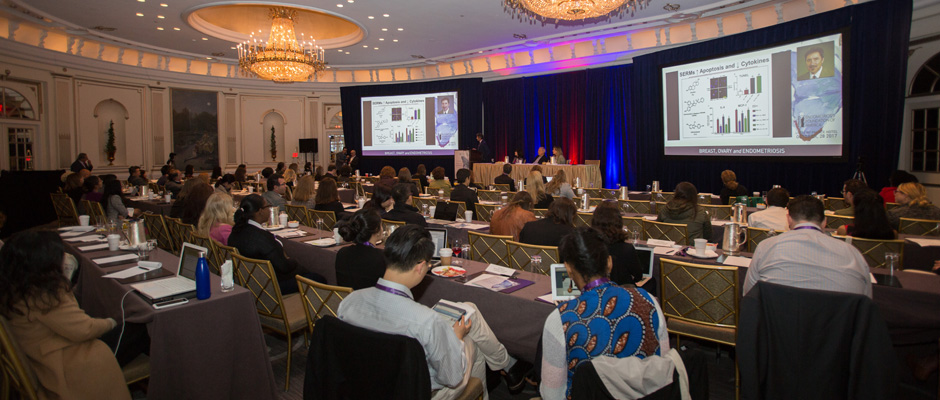
NEW YORK CITY—On October 28, endometriosis specialist and surgeon Dr. Tamer Seckin gathered 19 doctors, medical experts and researchers in a conference room at Lotte New York Palace Hotel to discuss endometriosis and its potential links to breast and ovarian cancers. He called the event the “first of its kind.” “We are not saying that endometriosis causes breast cancer or that breast cancer causes endometriosis,” Dr. Seckin, who is also the co-founder of the Endometriosis Foundation of America (Endofound), told an audience of about 100 (and an estimated additional 2,500 online viewers). “We are here [to discuss] sex steroids, etiologies.” Dr. Seckin added that he believes that, together, the three diseases need to be examined more closely; he also revealed that his father died from breast cancer and, earlier this year, so did two female colleagues. An estimated 200 million women worldwide have endometriosis, a reproductive disease in which uterine tissue grows outside of the uterus, causing pain, heavy menses and infertility. For more than nine hours, medical experts from research universities and hospitals from around the nation presented their findings, some of which were funded by the Endofound.
Thinking Pink
Breast health was also a focal point, especially in light of October being Breast Cancer Awareness Month, the symbol of which is a pink ribbon. Dr. Robert Taylor, a professor of research in obstetrics and gynecology at Wake Forest School of Medicine revealed that he and a team, including “world-class breast cancer investigator” Dr. Benita Katzenellenbogen, are conducting studies on ovariectomized mice, using hormones to inhibit growth and inflammation of endometriosis. He said the studies were inspired by “very good work in breast cancer [research].” Dr. Marisa Weiss, a breast oncologist and founder of breastcancer.org, discussed environmental risks and its effects on endometriosis and breast cancer. “Breast cancer was relatively rare 100 years ago,” said Dr. Weiss, adding that “90 percent of breast cancers” are not due to the inherited genes of BRCA1 or BRCA2, but environmental and lifestyle factors. “Early puberty is a risk factor for breast cancer, as it is for endometriosis,” she warned. “Breastfeeding lowers [the occurrence of] breast cancer and lowers the risk of endometriosis.” Dr. Weiss then explained her “Think Pink, Live Green” initiative, which encourages women to maintain a healthy weight, exercise and consume an organic, hormone-free, predominantly plant-based diet that minimizes environmental and manmade hormone disruptors like plasticizers, pesticides and hormones added to beef and dairy cows. (Dr. Seckin has also recommended the same diet and lifestyle for endometriosis sufferers.) Synthetic hormones are another way endometriosis and breast cancers intersect, says Dr. Weiss: “Birth control pills are used ubiquitously for so many reasons other than for just contraception.” Many doctors prescribe the pill to help suppress endometriosis symptoms. While Dr. Weiss says that practice introduces a small breast cancer risk for women in their teens and 20s, that changes with age. “When people continue to take birth control pills for an extended time, into their 30s or 40s, the risk of breast cancer starts to increase substantially.” While breast cancer risk increases for some, women “do get a benefit of reducing ovarian cancer risk when they’re taking birth control pills for five years.”
Eyes on the ovaries
Jeannine Villella, a chair of gynecologic oncology at Lenox Hill Hospital, examined the similarities between endometriosis and ovarian cancer. Endometriosis, like ovarian cancer, can remain in the ovaries, “but it also damages the tissue and causes the extensive fibrotic reaction, as does the malignant transformation of tissue,” said Villella. “And we know that this happens in both endometriosis as well as ovarian cancer due to genetic and immunological factors.” She pointed to studies showing a .72 percent chance of an endometrioma, or endometriosis-filled cyst, becoming malignant, but a three-fold risk of endo patients with endometriomas developing clear-cell ovarian carcinoma—what Villella called a very chemo-resistant cancer. Her presentation highlighted a handful of small studies done on women who self-reported having endometriosis. While researchers found that many later developed ovarian cancer, she cautions that researchers still have more work to do. “A firm causal relationship,” said Villella, “has not been established” between endometriosis and ovarian cancer. “Studies take 20 years to complete and maybe if we really looked at endometriosis, and we partnered with foundations such as Endofound, we can identify patients that we can watch long-term.” Still, there is some good news to be found for endometriosis sufferers: Villella pointed out that endometriosis is rarely fatal. And in endo patients who do develop ovarian cancer, the cancer is often caught sooner. “Maybe patients that are younger are screened more,” she explained. “They have pelvic pain, they already have endometriosis, [so] they’re being screened more by the gynecologist.”
Investing in knowledge
It seems, however, that The National Institutes of Health (NIH) could learn a few lessons from Endofound. Dr. Lisa Halvorson, chief of the Gynecologic Health and Disease Branch of the National Institute of Child Health and Human Development, showed the audience a graph that tracked grant-money expenditures from the government agency. According to the graph, the NIH spent at least $600 million in grant money on breast cancer research between 2013 and 2016. Meanwhile, ovarian cancer research hovered around the $100 million mark during the same period. But funding barely registered above the zero line on the chart for endometriosis studies. “This is relatively sad news,” she shared. “There’s a huge mismatch with the amount of money spent on these disorders and how frequently they occur in the population.”
Conference Videos : https://www.endofound.org/medical-conference-2017









